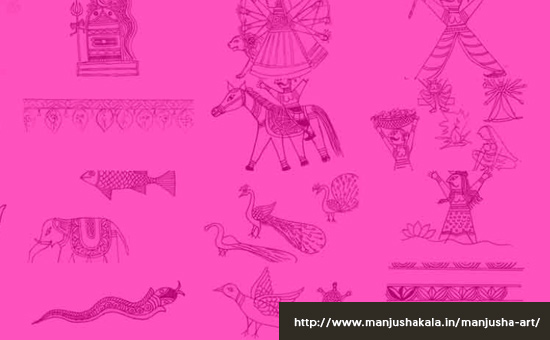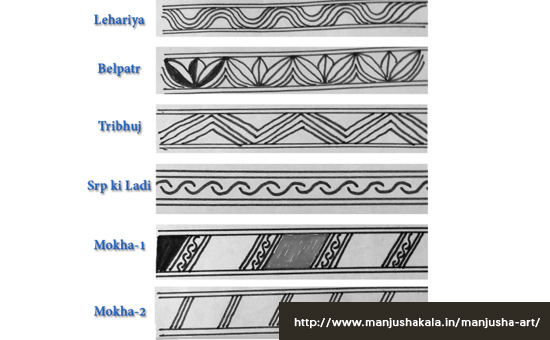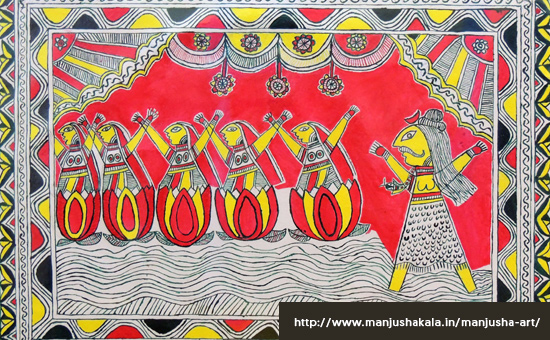- Manjusha
is a popular art form of Bihar. Article gives its history, process of making,
characters and motifs, its religious significance and importance.
History
Manjusha
art is an ancient folk art of ANG PRADESH. Ang Pradesh is currently known
as Bhagalpur city of Bihar. This art has been prevalent in Bhagalpur for a long
time. Manjusha Art came to the forefront between the time periods of 1931-1948.
During
this period, an ICS officer W.G. Archer and his wife started finding out more
about Manjusha art. He fell in love with the art form and put a collection
together followed by an exhibition in The India Office Library in London. That
exhibition became part of the Archer Collection.
It
was at this time that Manjusha art gained international recognition. But at
that time, due to the British rule, artisans could not flourish. After
this golden period, Manjusha art seemed to be fading away in the background.
This folk art was being practiced only by some people.
Manjusha Painting - The oldest Indian Painting Art
In earlier times this art was carved by only two families belonging to the Kumbhakar and the Malakar communities. Earlier these paintings were drawn on pots by Kumbhakar which were worshipped. And the Malakars made the actual “Manjusha” and painted Manjusha art on these structures.
The name of this art form also holds an interesting story. The Sanskrit word Manjusa means a ‘box’. These boxes were made from bamboo, Jute-Straw, and paper inside which the devotees kept their ceremonial materials.
The boxes were illustrated with paintings that tell a tale. And the tale was of Bihula who saved her husband from the deity’s wrath and a snake-bite and also of Bishahari or Mansa.

When
it comes to Manjusha paintings majorly three colours are used namely pink,
green, and yellow. These colours hold a significance; Pink is for Care,
Relation, Victory; Green is for Nature & Health, Dark green associated with
Financial Businesses; Yellow is for Joy, Young, Fun, Happy Feelings, Confidence,
Boost enthusiasm and Optimism.
With respect to colors, equally important is the art border. Every ‘Manjusha painting’ must contain one or more borders. Every work must have borders i.e.
1.
Belpatr in which the symbol of holy
Leafs of Belpatr. In Hindu tradition, we worship Lord Shiva with Belpatr Leafs.
2.
Lehariya in which symbol of Waves of
River is drawn.
3.
Mokha in this kind of border design and decoration.
4.
Tribhuj in which the triangle symbol borders are drawn.
5.
Srp Ki Ladi in which snake patterns are drawn on a border.

Process of Making the Art Form
When
a painting is started for religious purposes, the artist makes a pile of rice
in the room, places a betel leaf with a betel nut on top of this pile, and
prays for permission from the goddesses to start the painting. The moment the
leaf shifts a bit or falls, they consider this as a sign that they have got
permission and can start their work.
For
the painting, first an outline is drawn and then colours filled in. The outline
is usually drawn in green, but today some artists also use black colour.
In
traditional paintings, rulers and other instruments were not used as it was
felt that the little imperfections added to the raw nature of the art; however,
nowadays various instruments are used to make the paintings symmetrical and
precise.

Characters and Motifs in Manjusha art
All the characters in Manjusha paintings are drawn in a distinct manner. Human forms are depicted in the form of letter ‘X’ with raised limbs. The main characters are portrayed with big eyes and without ears.
Bishaharis are represented
in the same way except they can be distinguished by what they hold in their
hands: Jaya Bishahari holds a bow and arrow with amrit kalash in one hand and
snake in the other, Dhotila Bishahari has a rising sun in one hand and a snake
in the other, Padmavathi Bishahari has lotus in one hand and a snake in the
other, Mynah Bishahari has mynah in one hand and a snake in the other, and
Maya/Manasa Bishahari holds snakes in both hands.
The religious significance of this art –
The festival of Bisahari’s is celebrated on the 17th and 18th August of every year.
During this pooja, there are two things that are made during this pooja.
One is the “Kalash” and the other the Manjusa. The Kalash is made by the Kumbhakar and Manjushas by the Malakars.
Each
is decorated with the art of Manjusha which depicts these stories and are
immersed in the lake at the end of the festival.
They worship Bisahari as they believe that they will get
strength from her and her protection. She promises that their husbands will be
protected from all the snakes. They worship Bihula to gain her strength and
blessings and also to pray for the long life of their husbands.
There is also a ritual in which the groom before getting married, is asked to go into a small house in which, in all the four corners of the room/house there is a painting of Bisahari. The groom has to put sindhoor to all four of the Bisaharis and only then can take his bride to the mandap and all other wedding festivities and rituals can start. This is done with the belief that since the groom puts sindhoor for bisahari first, he is married to her first and thus pleases her. The figures are called “nainajogini.”
Good News for Manjusha Art Lovers
Manjusha
art is one of the famous art forms. Now the good news for the lovers of
Manjusha painting is that this painting will be reflected now on clothes also.
From sarees and salwar suit to shirts new and different designs were going to
take place and it definitely attracts people.
Revival of the Artform
Art
and culture go hand in hand. One cannot thrive without the other and is bound
to perish alone. It is hard to fathom a civilization without running down a
train of thoughts about its art forms. From the cavemen doodling with rocks and
stones to the modern painters with their sand art, mankind has always made it a
necessary hobby to sketch his surroundings.
These
art forms are also the source of ancient knowledge and traditions. The
paintings and craftworks have carried with them the culture over generations
and it is owing to them that we know a great deal about world history. They
have also been a source of numerous folklores and a voice to many stories.
Art
blended with godlore and is just a cherry on top. One such traditional art form
has been the Manjusha art.
It
is also important to mention here that Manjusha and
Madhubani both are famous art forms of Bihar but at the same time are
far cry from each other.
Manjushas
are very specific whereas Madhubani is more flexible in its styles. And while
Madhubani received ample attention, the former is still struggling for
survival.
Manjusha
art is much more than just an art form. Being the only sequential art form of
the country, it is of considerable cultural value and has a vast heritage
appurtenant to it. It vividly reflects the history of ancient Ang Mahajanpada.
It can also be acknowledged as a means of empowering women artist as women are
mostly associated with these paintings.
And
it goes without saying that it is high time that the necessary measures are
taken to protect this canvas from going blank forever.

Importance of Manjusha Art
1. It is an ancient and historically significant art form, considered on par with Madhubani art.
2. Manjusha Art or Manjusha Kala is often referred to as Snake Paintings by foreigners as swirling snakes in the art depict the central character Bihula’s tale of love and sacrifice.
3.
A recent study on Manjusha Art provides an excellent example of how this art
reflects the history of ancient Anga Mahajanapada.
Author is a Mumbai based artist.
The
purpose of this compilation is to document and promote. We have given credits
and reference links in this compilation. In case some are missed, it is not
with malafide intent.
To read all
articles by author
Reference
and credits for images is http://www.manjushakala.in/manjusha-art/